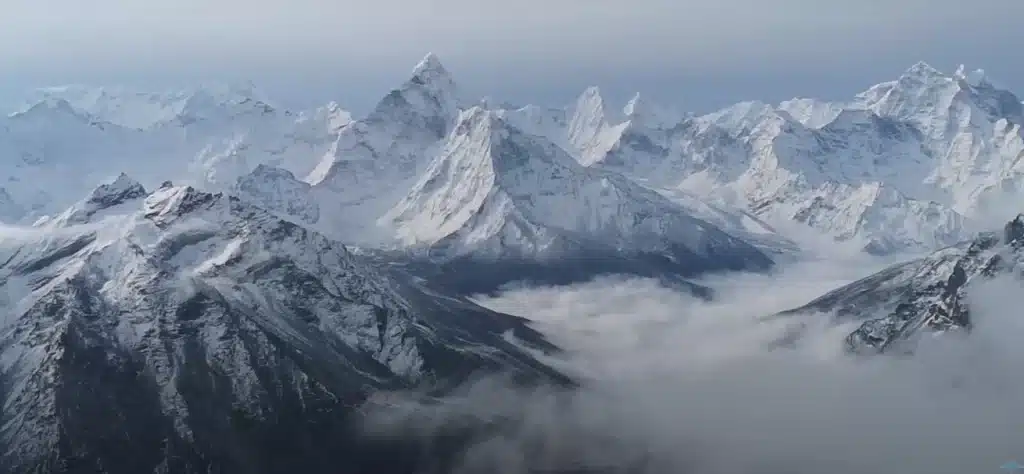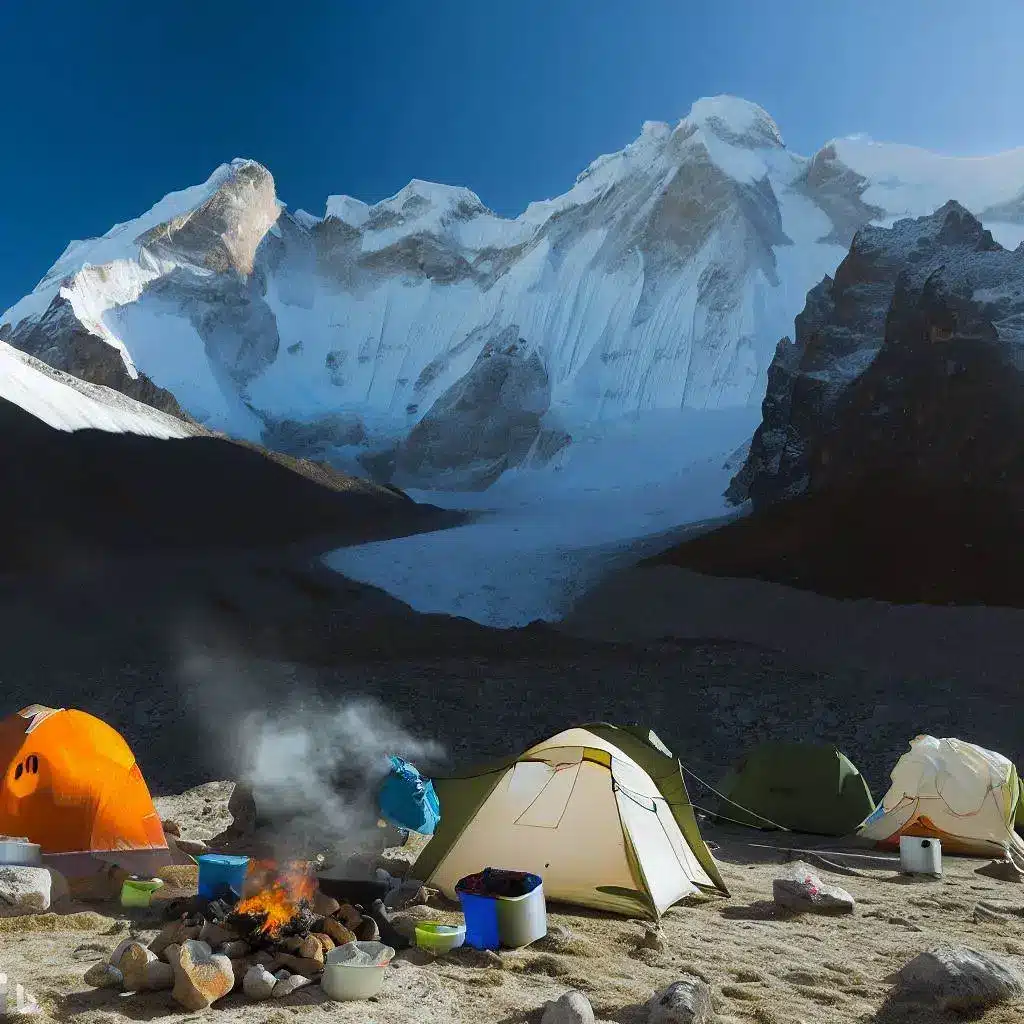Lobuche Peak Climbing Difficulty
Lobuche Peak, also known as Lobuche East, stands proudly at an elevation of 6,119 meters (20,075 feet) in the renowned Sagarmatha National Park. Located in the Khumbu region of Nepal, it forms part of the stunning Mahalangur Himalayan range and presents an exhilarating challenge for climbers seeking an adrenaline-fueled adventure.
However, before setting foot on this majestic peak, it is essential to understand the Lobuche Peak Climbing difficulty that awaits those daring enough to conquer its slopes. In this informative guide, we will explore the unique factors that contribute to the difficulty level of Lobuche Peak climbing, providing you with valuable insights to prepare for this extraordinary mountaineering endeavor.
Table of Contents
The distinction between Lobuche West and Lobuche East

It’s important to note that Lobuche Peak is often referred to as both Lobuche West and Lobuche East. While Lobuche East is the lower of the two peaks, reaching a majestic altitude of 6,119 meters, Lobuche West stands slightly higher at 6,135 meters (20,161 feet).
Lobuche West is renowned for its challenging technical sections, including steep ice and rock faces, which demand advanced climbing techniques like ice climbing and rock scrambling. Due to its difficulty level, Lobuche West is a popular choice among seasoned climbers looking for a more demanding and rewarding ascent.
On the other hand, Lobuche East, standing at an elevation of 6,119 meters (20,075 feet), is slightly lower than Lobuche West but still poses a formidable challenge. Lobuche East is relatively less technical compared to its counterpart, making it more accessible to climbers with intermediate mountaineering skills.
While it may not require the same level of technical expertise, climbers attempting Lobuche East still need to be well-prepared and have experience in high-altitude trekking and basic mountaineering techniques.
It’s worth mentioning that Lobuche East is more frequently climbed than Lobuche West, primarily due to its accessibility and popularity among climbers who seek a challenging but achievable goal.
Whether you choose to conquer Lobuche West or Lobuche East, both peaks demand physical endurance, mental resilience, and adequate acclimatization to the high altitude. It is essential to undertake thorough research, consult experienced guides, and join reputable expedition teams like us to ensure a safe and successful climb. For more details about how you can train for the Lobuche Peak climbing, check out our “How to train for Peak Climbing” guide.
Highlights of Lobuche Peak Climbing
- As climbers ascend Lobuche Peak, they are treated to awe-inspiring vistas of the Khumbu Valley, including the iconic peaks of Everest, Lhotse, Nuptse, and Ama Dablam.
- Climbing Lobuche Peak requires technical expertise and mountaineering skills. The route to the summit presents various challenges, including steep sections, rocky terrain, and a snow-filled ascent.
- The journey to Lobuche Peak takes climbers through Sherpa villages and Buddhist monasteries, providing an opportunity to immerse themselves in the rich local culture and traditions.
- During the climb, climbers establish a high camp, usually around 5,400 meters (17,717 feet). This camp serves as a base for the final summit push and offers a unique camping experience amidst the pristine Himalayan wilderness.
Factors Contributing to Lobuche Peak Climbing Difficulty
Climbing Lobuche Peak is a thrilling and rewarding adventure that attracts mountaineers from around the world. However, it is essential to understand the various factors that contribute to the difficulty of this climb. The major factors that contribute to Lobuche Peak Climbing difficulty are:
A. Temperature, Climate, and Weather
1. Cold temperatures and the need for warm gear
One of the primary factors that mountaineers must contend with when climbing Lobuche Peak is the extreme cold. The peak is located in the Khumbu region of Nepal, where temperatures can plummet significantly, especially at higher altitudes.
As a result, climbers must equip themselves with appropriate warm gear, including insulated clothing, gloves, hats, and boots, to protect themselves from frostbite and hypothermia. Adequate layering and insulation become vital to combat frigid temperatures and ensure the safety and comfort of climbers.
2. Variation in temperature based on seasons
The temperature on Lobuche Peak can vary significantly depending on the time of year. During the spring and autumn seasons, which are considered the best times for climbing, the temperatures are relatively milder, making the ascent comparatively more manageable.
However, during winter and monsoon seasons, the temperature drops drastically, making the climb significantly more challenging and dangerous. Climbers must be well-prepared and choose the optimal season for their expedition to mitigate the adverse effects of extreme temperature variations.
3. Harsh cold conditions and their impact on the climbing difficulty
The harsh cold conditions experienced during Lobuche Peak climbing can have a profound impact on the overall difficulty of the ascent. The combination of low temperatures, high winds, and sometimes sub-zero wind chills creates a hostile environment that requires climbers to possess exceptional physical and mental resilience.
Cold weather can affect the body’s functioning, leading to reduced dexterity, decreased energy levels, and increased fatigue. It is crucial for climbers to acclimatize properly, maintain hydration and nutrition, and be aware of the signs of altitude sickness exacerbated by the cold.
How to be prepared for cold temperatures, climate, or Weather in Lobuche Peak Climbing?
Climbers must prioritize their safety when it comes to cold temperatures. Insulated gloves are essential to keep the hands warm and prevent frostbite. Insulated hats or balaclavas are crucial for keeping the head and face protected from the cold, as significant heat loss can occur from these areas. Climbers need sturdy boots that are insulated, waterproof and have good traction.
It’s important to note that climbers should avoid cotton clothing as it retains moisture and can lead to discomfort and increased cooling. Synthetic or wool materials are better options as they wick away sweat and maintain warmth even when wet.
B. Steep and Uneven Trails
Lobuche Peak, situated in the majestic Himalayas, presents climbers with steep and uneven trails that demand physical endurance and mental resilience. The ascent includes rocky sections, icy slopes, and narrow ridges, adding to the difficulty level.
The altitude gain intensifies the challenge, making it crucial for climbers to acclimatize properly and maintain a steady pace. A combination of strength, stamina, and technical skills is required to navigate these arduous terrains successfully. Similarly, here is the impact of Steep and Uneaven Trails in Lobuche Peak Climbing.
1. Challenges faced by beginners on the climb
For beginners venturing into Lobuche Peak climbing, the steep and Uneven Trails pose additional obstacles. The high altitude and demanding nature of the climb can be overwhelming for those without prior mountaineering experience.
The steep sections of the trail demand a steady uphill climb, testing the climbers’ leg strength and cardiovascular fitness which can be challenging for beginner climbers. To tackle the steep and uneven trails effectively, climbers should engage in physical training that focuses on building leg strength, cardiovascular endurance, and balance.
Practice on similar terrains, such as hiking on hilly or rocky trails, can also help familiarize climbers with the challenges they will face on Lobuche Peak.
C. Camping and Food Challenges

Camping during Lobuche Peak climbing presents its own set of challenges. The extreme weather conditions, limited resources, and lack of facilities at higher altitudes require climbers to be self-sufficient.
Similarly, camping on Lobuche Peak typically involves establishing base camps at different altitudes to facilitate the gradual acclimatization process. Setting up camps in such extreme environments requires careful planning, proper equipment, and knowledge of the terrain.
One of the primary challenges of camping in the high-altitude region is the scarcity of suitable camping sites. The rugged terrain, lack of level ground, and presence of rocks and ice make finding suitable spots for tents a difficult task. Climbers often have to improvise and adapt to the available space, ensuring that the campsite is secure and protected from potential hazards like avalanches or strong winds.
Moreover, Cooking at high altitudes can also be a challenge due to the lower boiling point of water. This means that food takes longer to cook, and fuel consumption may increase. Climbers must adapt their cooking methods and be mindful of conserving fuel to ensure an adequate supply throughout the expedition.
Carrying lightweight and durable camping gear is also crucial, as it can make a significant difference in the overall comfort and safety of the expedition. Furthermore, planning and packing nutritious meals that provide adequate energy become essential for sustaining the physical demands of the climb.
D. Challenges in finding proper accommodation
Accommodation options are limited during the Lobuche Peak climbing journey. Tea houses and lodges along the trail provide basic amenities but may not always be available or suitable for climbers. In remote mountainous areas like Khumbu Region, facilities are often basic, with limited amenities and services. Climbers may need to adjust their expectations and be prepared for more rustic and minimalist accommodations.
In some cases, climbers may need to rely on expedition-style camping as their primary form of accommodation. This requires carrying camping gear, including tents, sleeping bags, and cooking equipment.
Ultimately, while challenges in finding proper accommodation exist during mountaineering expeditions to Lobuche Peak, proper preparation, flexibility, and a positive mindset can help climbers navigate these hurdles and focus on the breathtaking beauty and rewarding experiences that the climb has to offer.
Technical Aspects of Summiting Lobuche Peak
Moderate-level Climb Suitable for Most climbers
Lobuche Peak is often regarded as an ideal choice for climbers with prior mountaineering experience. It presents a moderate level of difficulty, making it accessible to most climbers who have a good fitness level and some previous climbing experience.
The route to the summit of Lobuche Peak typically involves sections of snow and ice climbing. Climbers need to be proficient in using crampons, ice axes, and other necessary equipment to ascend and descend these icy slopes safely.
However, the climb offers an exciting challenge without requiring extensive technical expertise or high-altitude mountaineering skills. Adequate preparation and training are still essential to ensure a safe and enjoyable experience.
Challenging section below the summit with a 45° slope
One of the highlights, and perhaps the most demanding part, of Lobuche Peak climbing is the challenging section below the summit. As climbers approach the upper reaches, they encounter a steep slope with an approximate 45° incline.
This section demands careful footwork, proper use of climbing techniques, and a focused mindset. Climbers should be prepared for a physically demanding ascent and be equipped with the necessary skills to navigate this challenging segment successfully.
Lengthy duration and requirement of climbing gear
Summiting Lobuche Peak is not an endeavor to be taken lightly. The climb typically requires a duration of around 18 to 21 days, including acclimatization and preparation periods. It is crucial to acclimatize properly to the high altitude to minimize the risk of altitude sickness and ensure a higher chance of success.
To undertake the climb, climbers must also have the appropriate climbing gear. This includes essential equipment such as ice axes, crampons, harnesses, ropes, helmets, and suitable mountaineering boots. It is crucial to have a thorough understanding of how to properly use and maintain this equipment.
Time Required for Climb/Duration of the Lobuche Peak Climb
Daily walking hours and estimated time for the summit
The Lobuche Peak climbing expedition demands physical endurance and mental resilience. To make progress towards the summit, climbers typically cover an average of 5 to 7 hours of trekking each day.
The duration may vary based on individual fitness levels, weather conditions, and group dynamics. It’s essential to maintain a steady pace and take short breaks for hydration and rest to optimize your energy levels throughout the climb.
Estimated Time for the Summit:
As you ascend Lobuche Peak, the path becomes increasingly challenging, and the altitude presents its own set of obstacles. The estimated time to reach the summit largely depends on various factors, including your climbing experience, acclimatization, and overall fitness.
On average, climbers can anticipate spending around 3 to 4 days on Lobuche Peak, with the summit attempt usually occurring on the fourth or fifth day of the expedition.
During the summit push, climbers generally start in the early morning hours to take advantage of favorable weather conditions and ensure a safe return. The final push to the summit can take approximately 8 to 10 hours, including breaks. It’s important to remember that this estimate can vary, and climbers should be prepared for unexpected challenges that might impact the timing.
Importance of following an outlined itinerary for a successful climb
A well-structured itinerary is the backbone of a successful Lobuche Peak climbing expedition. It serves as a roadmap, guiding climbers through different camps, acclimatization days, and the final ascent. Following an outlined itinerary is crucial for several reasons:
Acclimatization: Lobuche Peak climbing involves ascending to high altitudes where the risk of altitude-related illnesses, such as Acute Mountain Sickness (AMS), increases. An appropriately designed itinerary includes acclimatization days, allowing climbers to adjust to the thin air and reduce the chances of altitude sickness. This gradual ascent enhances safety and increases the likelihood of summit success.
Optimal Physical Preparation: An outlined itinerary helps climbers plan their training and physical conditioning effectively. It provides a clear timeline to focus on building stamina, endurance, and strength, ensuring that climbers are adequately prepared to face the challenges of Lobuche Peak.
Resource Allocation: By adhering to an itinerary, climbers can make informed decisions about resource management, including food, water, and equipment requirements. This strategic approach minimizes the risk of running out of essential supplies during the climb, contributing to a smoother and more enjoyable experience.
Safety and Contingency Planning: An itinerary allows for contingency plans in case of unforeseen circumstances, such as inclement weather or unexpected difficulties. Flexibility within the outlined schedule ensures that climbers can adapt to changing conditions while maintaining safety as a top priority.
Conclusion
In conclusion, Lobuche Peak climbing presents an exhilarating and challenging adventure for mountaineers seeking to test their limits in the majestic Himalayas. Understanding the distinct features of Lobuche West and Lobuche East is crucial when planning your expedition, as they offer different levels of difficulty and technical requirements.
Factors such as temperature, climate, and weather play a significant role in the climbing difficulty of Lobuche Peak. The extreme cold, fluctuating temperatures, and harsh conditions demand proper acclimatization, suitable gear, and a resilient mindset.
The steep and uneven trails of Lobuche Peak require physical endurance, technical skills, and careful navigation. Beginners should be prepared for the challenges posed by high altitudes and gain prior mountaineering experience before attempting this climb.
Camping and food challenges, along with limited accommodation options, necessitate self-sufficiency and proper planning. Carrying lightweight camping gear and packing nutritious meals are vital for a comfortable and successful climb.
In summary, Lobuche Peak climbing is an extraordinary adventure that demands physical, mental, and technical capabilities. By understanding the climbing difficulty, preparing adequately, and adhering to a well-structured itinerary, you can embark on this remarkable journey and conquer the heights of Lobuche Peak with confidence. So, lace up your boots, gear up, and get ready to embrace the challenges and rewards that await you on this epic mountaineering expedition.



